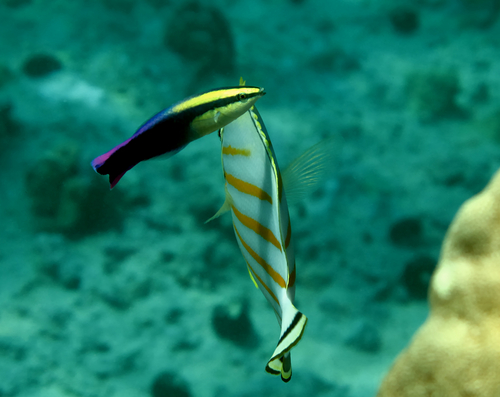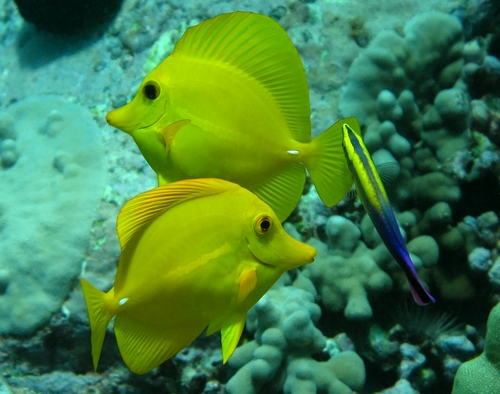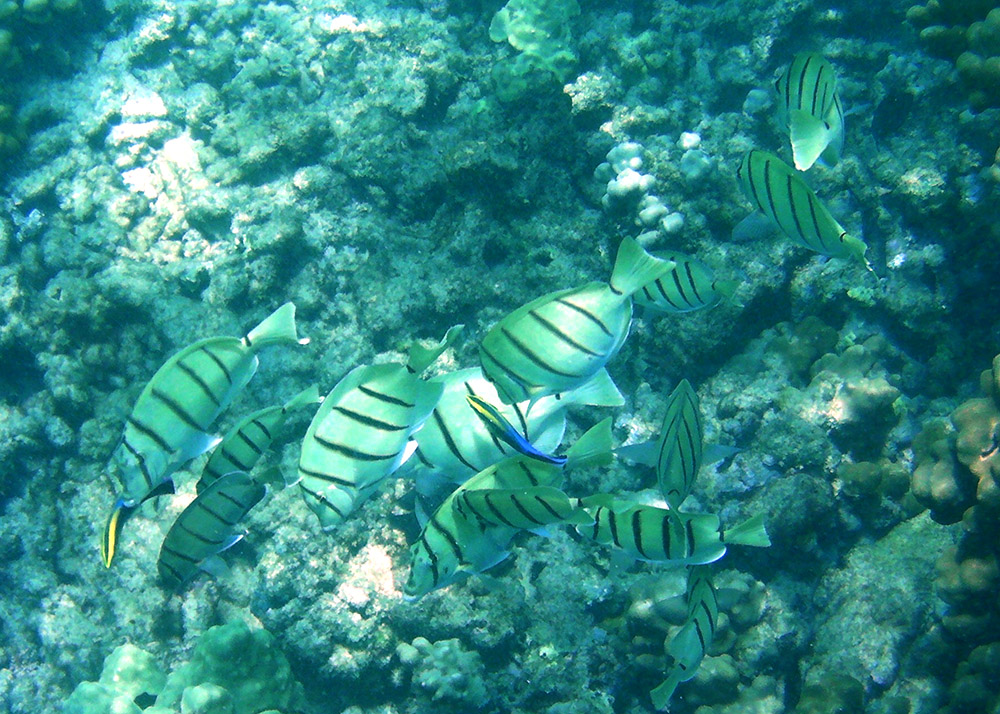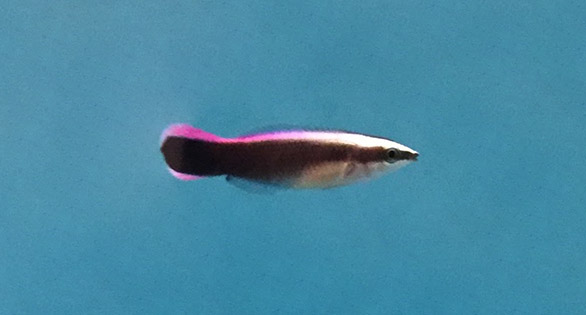
A Hawaiian Cleaner Wrasse is visited by the Ornate or Clown Butterflyfish, Chaetodon ornatissimus; both species have “avoid at all cost” reputations in the aquarium hobby due to poor feeding track records. But with husbandry and breeding breakthroughs, those reputations could one day change. Image credit: Karl Keller/Shutterstock
This week’s announcements of three Hawaiian endemic aquarium fish species being aquacultured, culminating with the successful captive-breeding of the “impossible to keep” Hawaiian Cleaner Wrasse, shows that the aquarium world is responding to threats to wild reefs and finding new routes to support wild populations as part of a sustainable Hawaii’s aquarium fishery.
opinion by Matt Pedersen
In today’s unavoidable political climate, you can become almost immune to the notion of hyperbole and deception as a tool to push an agenda; it’s now the defacto norm. It takes so much to weed through it, you might just stop trying…you might even just start believing it. These days, it’s very easy to overwhelm someone with so much false information that there’s no way to dig out, and that particular brand of gaslighting is definitely a hallmark of the anti-aquarium activists in Hawaii.
I owe a special thanks to David Gross, who introduced me to the correct term for this debating practice: the Gish Gallop. On some levels it feels like the anti-aquarium activist’s Gish Gallop is in fact working. It seems that the only sensible retort, the only thing that’s gonna shut ’em down, is a Mic Drop: sidestep the entire argument by proving it irrelevant in one fell swoop. News releases from Rising Tide Conservation all week have been leading up to this definitive moment.
Intellectual Honesty
While the aquarium trade certainly has room for improvement (as we all do), I think we’ve done a pretty good job, over time, of recognizing when things need to change. Information has been, and continues to be, available for those who want it.
Case in point: most of us can agree that Cleaner Wrasse species of the genus Labroides have long been viewed as difficult-to-keep fish in the aquarium hobby, and the Hawaiian Cleaner Wrasse (Labroides phthirophagus) has been generally termed a species to avoid at all costs, classified as an obligate cleaner, generally rumored to be a fish that won’t eat in captivity.
Bob Fenner draws this distinction when comparing species like the Hawaiian Cleaner Wrasse with the far more common Cleaner Wrasse (Labroides dimidiatus), which he considered the one species of cleaner wrasse to attempt in captivity (the best out of perhaps nothing but bad-to-worse choices, as I read it). Fenner’s reluctant suggestion stems from the idea that the common Cleaner Wrasse “seems” to be a less obligate, more facultative cleaner wrasse species.
Indeed, examples of the common Cleaner Wrasse adapting to captivity, feeding on a wide range of prepared diets, spawning for many hobbyists, and even being successfully captive-bred by Bali Aquarich “accidentally” while rearing a mixed spawn from angelfish broodstock, change the narrative. These examples make clear that while it is certainly not a beginner’s fish, when starting with good quality fish in the hands of experienced aquarists, the common Cleaner Wrasse can be kept. But what about the Hawaiian Cleaner Wrasse?
An Activist’s Second Poster Child

Robert Wintner’s two favorite poster child species in his ongoing campaign to end the aquarium trade in Hawaii, the Yellow Tang (Zebrasoma flavescens) and the Hawaiian Cleaner Wrasse (Labroides phthirophagus). Image credit: Karl Keller/Shutterstock
Turning to the Hawaiian Cleaner Wrasse, one of Hawaii’s most vocal anti-aquarium spokesmen, Robert Winter, paints a rather colorful, yet bleak picture for this species, known by its Hawiian name, Hinalea.
From the film A Different Kind Of Farm, Winter rhapsodizes, “Besides Yellow Tangs being the brunt of the injury to Hawaii reefs, the most soulful insult is the Hawaiian Cleaner Wrasse. He is endemic, and he is technically described as a charismatic fish. The average Hawaiian Cleaner Wrasse has a smile on his face. He is radiant yellow, purple, blue, black, and he’s always on the move. He’s irrepressible. He’s in your face, he’s over there. And it’s this body language—it’s nonstop body language—that’s an invitation to the other species to come in and be groomed. And the Hawaiian Cleaner Wrasse picks parasites from the skins and scales of other species of fish. ”
But this is where the story changes, and the facts get blurry, as Winter’s prose then turns to condemnation: “Without the cleaner wrasse, a reef is exposed to parasite infestation. If you do a search for Hawaiian Cleaner Wrasse, you’ll find them for sale for $50. There is no limit on the catch. They ship out from Hawaii every day by the hundreds. They will die of starvation in 30 days, unless they have 30 other fish to clean. Very few tanks, an infinitesimally small fraction, have 30 fish.”
In another anti-aquarium PSA featuring the Hawaiian Cleaner Wrasse, Wintner is equally blunt. “A Hawaiian Cleaner Wrasse will not eat in captivity, and starves to death quickly. Aquarium hobbyists are willing to take the loss for a few days of colorful, charismatic entertainment. Are you willing to take the loss? Let’s ban the aquarium trade in Hawaii now.”

Manini (Convict Tangs) and Cleaner Wrasse at Lawai – image by Pat McGrath – CC-BY-2.0
Dissecting the Rhetoric
Now, Wintner certainly doesn’t speak for any aquarium hobbyist I know, and I don’t think any of us are happy to throw away $50 (as he puts it) on something that’s going to live just a few days in our tanks. But is Wintner entirely full of it?
True, research has shown that the long-term and complete removal of the cleaner wrasse Labroides dimidiatus from small reefs does have an impact on the fish populations that inhabit and visit the reef (read Long-Term Effects of the Cleaner Fish Labroides dimidiatus on Coral Reef Communities, Waldie et. al., 2011); therefore, it seems logical to extrapolate and presume that the same *might* be true if this experiment was done in Hawaii using L. phthriophagus. Yet it’s also interesting to note that, according to the IUCN Red List, “80% of this species range is within the Papahanaumokuakea Marine National Monument, a well protected marine park in the Northern Hawaiian Islands.”
It’s much harder to say whether there is truth in Wintner’s claim that “hundreds” ship out of Hawaii every day; since it’s a native species to the US, it’s not “imported,” and thus the data available at AquariumTradeData.org certainly don’t capture the true number, although it’s interesting to compare the data recorded for all Cleaner Wrasse species as reported for 2011:
- 78,226 – Labroides dimidiatus
- 2,972 – Labroides spp.
- 1,051 – Labroides bicolor
- 477 – Labroides pectoralis
- 324 – Labroides phthriophagus
- 36 – Labroides rubrolabiatus
One interesting bit of historical data: according to The Commercial Marine Aquarium Fishery in Hawai’i 1976-2003, by Walsh et. al., from 1967 to 2003, the total reported catch of Hawaiian Cleaner Wrasse was 51,650. That averages about 4 per day over that 36-year period. Anti-aquarium activists love to say the actual data is “double.” Ok, so let’s call it 8 per day? Even that seems to fall significantly short of Winter’s hyperbolic “hundreds per day.”
Is there no limit on the catch? Well, there may not have been in 2011 when Wintner spoke, but these days the Hawaiian Cleaner Wrasse isn’t on the West Hawaii / Kona White-List of 40 species permitted to be collected; in that fishery, the limit of harvest is “no harvest.” Those Hawaiian Cleaner Wrasses that are leaving the state of Hawaii are only leaving from smaller fisheries where their collection is still permitted. With such limited access to the species, between the unofficial black-listing and most of its range being off limits, never mind the aquarium community’s general recommendation to not purchase the fish in the first place, I’m finding it very hard to think there’s any truth to the notion of hundreds leaving Hawaii each day.
I took Wintner’s suggestion to do a quick Internet search. Results from leading online aquarium fish retailers basically suggest that this species it not available (it’s either not listed, or if listed is out of stock). If it ever is available, it looks like the price has gone up a bit: $60 to $90 seems to be the online suggested retail price (for a fish that’s not in stock at any vendor).
I have no clue where Wintner got the magic formula that 30 fish in a tank is what’s required to successfully keep a Hawaiian Cleaner Wrasse alive in captivity. Will I fail to keep the species alive if I only have 29? What if all the other tank-mates are the tiny, parasite-cleaning Neon Gobies (Elacatinus oceanops)? We’ve come to learn that “rules of thumb” in the aquarium hobby are often quite flawed; Wintner’s suggested rule of thumb for successfully keeping the Hawaiian Cleaner Wrasse is just utter nonsense.
I could go on like this for years, fighting each claim one by one, and Wintner would still get air time, still get quoted, still raise the same old exaggerated or outlandish arguments, and still get people to buy in. But that all changes, now.
Rising Tide’s Sea Change
Thursday evening, August 25th, an aquarium industry friend remarked over the phone that Avier J. Montalvo must be angling hard for “MASNA Aquarist of the Year,” given this week’s announcements of his successes with breeding Potter’s Angelfish (Centropyge potteri) (announced on Monday), followed by a second species first claim (officially made on Wednesday), with the announcement of the breeding of the Lemon or Milletseed Butterflyfish (Chaetodon miliaris). I joked, saying, “I already know who the MASNA Aquarist of the Year Is” (being one myself, I’m part of the committee that ultimately votes for the recipient). But I also let my friend know, as I suggested to anyone who read to the end of Wednesday’s article, that Montalvo, OI, and Rising Tide weren’t done with this week. “Just wait until tomorrow,” I teased.
Well, tomorrow is here, and it’s fair to say that Avier J. Montalvo, working as an intern at the Oceanic Institute at Hawaii Pacific University under the auspices of Rising Tide Conservation, basically just threw down the most epic rebuttal the anti-aquarium activists have ever experienced.
Mr. Wintner, Hinalea, the Hawaiian Cleaner Wrasse, the fish we purportedly can’t even keep alive in captivity for 30 days, has been successfully bred in captivity. Twice.
*MIC DROP*

In case it wasn’t clear enough (Obama Mic Drop via Giphy)
Postscript
Now, I could pose the question to Wintner, “How does a fish that starves in captivity within 30 days manage to live, reproduce, and have those offspring grow to be over 118 days old?” But that is just poor sportsmanship at best. As an outsider motivated by emotions and a sense of moral outrage, how could Wintner ever approach this question? Most likely, any anti-aquarium trade response to this week’s news will be to paint it as false hope or an empty promise, and to suggest that this will somehow spur hundreds of thousands of additional Hawaiian Cleaner Wrasses to be harvested from Hawaii’s Reefs. Sorry, it’s just that obvious; they left their playbook sitting open on the bench, turned to the page titled “Backhanded Congratulations.” (or they’re just ignore it, as it doesn’t support their narrative).
Clearly, making absolute statements about the husbandry of a fish they’ve never even kept is a great way to be proven foolish. Anti-trade activists’ dealing in absolutes is a surefire way to get proven wrong. Dealing in absolutes is also a great way to inspire people to prove you wrong. If there’s one thing I’ve seen aquarium keepers of all types do, it is prove that the unthinkable can and will be achieved. The hobby, the science, the industry, only goes in one direction—forward.
A Gut Check
I spoke with Dr. Chad Callan, Director of the FinFish Program for the Oceanic Institute of Hawaii Pacific University, and he provided a great summary of their work to date. “We are really excited to see the methods that have been developed for culturing species like Yellow Tang successfully applied to other important Hawaiian reef species. The culture of the Hawaiian Cleaner Wrasse further demonstrates that many of the principles we have developed and learned are transferable across a wide range of fish. However, I’d still like to point out that this isn’t easy! This success took the same type of team effort in broodstock care, live feeds culture and larval rearing to facilitate the process [as the Yellow Tangs have]. We are looking forward to continuing to refine and apply these methods to other species!”
In less than 12 months, researchers working at the Oceanic Institute have staked their claim on the successful first breeding of four species of Hawaiian endemics. While this is still probably years away from large-scale, industry-shaping commercial impact, it’s not unfair to say that both Hawaii’s aquarium fishers and the anti-aquarium trade activists they inspire, have been put on notice.
Where the aquaculture of Hawaii’s aquarium fishery target species was largely pie-in-the-sky thinking for decades, it is now tangibly possible. That’s not to say that breeding is the answer to the conflict over Hawaii’s aquarium fishery. Whether breeding Hawaii’s aquarium fish is commercially practical or viable are questions that will take years to answer, but the days of the Boolean choice—either wild fish or no fish at all—are over. The conversation will evolve because our knowledge has deepened. To that end, we have Avier J. Montalvo, the Oceanic Institute at Hawaii Pacific University, and Rising Tide Conservation, to thank.






*THUNDEROUS APPLAUSE*